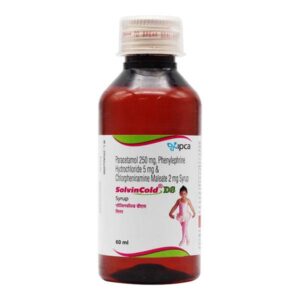CHLORPHENIRAMINE + PARACETAMOL + PHENYLEPHRINE
Chlorpheniramine: Chlorpheniramine is an antihistamine drug primarily used to treat allergy symptoms such as sneezing, itching, watery eyes, and runny nose. It can also be used to manage symptoms of the common cold and hay fever.
The drug works by blocking the effects of histamine, a chemical in the body that is responsible for triggering allergic reactions. By blocking histamine receptors, Chlorpheniramine helps to alleviate the symptoms associated with allergies.
Chlorpheniramine is available in different formulations such as tablets, capsules, and liquid. The dosage may vary depending on the age, weight, and condition of the individual. It is best to follow the instructions provided by the healthcare professional or the directions on the product packaging.
It is important to note that Chlorpheniramine may cause some side effects. Common side effects may include drowsiness, dizziness, dry mouth, constipation, and blurred vision. These side effects are usually mild and temporary. However, if they persist or worsen, it is recommended to consult a healthcare professional.
In rare cases, Chlorpheniramine can cause more serious side effects such as difficulty urinating, irregular heartbeat, or allergic reactions. If any of these symptoms occur, medical attention should be sought immediately.
Chlorpheniramine may also interact with other medications, such as sedatives, tranquilizers, or monoamine oxidase inhibitors (MAOIs). It is important to inform the healthcare professional about all medications being taken to avoid potential drug interactions.
Overall, Chlorpheniramine is a commonly used antihistamine drug that effectively relieves allergy symptoms. However, it is essential to use it as directed and be aware of the possible side effects.
Paracetamol: Paracetamol, also known as acetaminophen, is a commonly used over-the-counter drug that belongs to the class of analgesics (pain relievers) and antipyretics (fever reducers). It is primarily used to manage mild to moderate pain and reduce fever.
The exact mechanism of action of paracetamol is not completely understood. However, it is believed to work by inhibiting the production of prostaglandins in the central nervous system, which are responsible for pain and fever. Paracetamol is also thought to act directly on the hypothalamic heat-regulating centers to lower body temperature.
The recommended dose of paracetamol typically varies depending on the age and weight of the individual. For adults, the usual dose is 325-1000mg per dose, with a maximum daily dose of 4000mg. It is important to follow the instructions on the packaging or consult a healthcare professional to determine the appropriate dosage.
While paracetamol is generally considered safe when used as directed, it may cause certain side effects. Common side effects include nausea, vomiting, abdominal pain, and skin rashes. In rare cases, it can cause severe allergic reactions, such as difficulty breathing, swelling of the face or throat, and hives. Prolonged or excessive use of paracetamol can lead to liver damage, so it is crucial to adhere to the recommended dose and not to use it for an extended period without medical guidance.
It’s important to note that paracetamol may interact with other drugs, including alcohol, and individuals with certain health conditions, such as liver disease or alcohol addiction, should exercise caution and consult a healthcare professional before taking this medication.
Phenylephrine: Phenylephrine is a medication commonly used as a nasal decongestant, to treat symptoms such as stuffy or blocked nose due to allergies, colds, or sinusitis. It belongs to a class of drugs called sympathomimetic agents, which work by constricting blood vessels in the nasal passages, thereby reducing swelling and congestion.
Phenylephrine works by stimulating alpha-adrenergic receptors in the smooth muscles of blood vessels, causing constriction and reducing blood flow. This results in a decrease in nasal congestion and a reduction in the production of mucus.
The typical dose of Phenylephrine varies depending on the formulation and the age of the patient. It is available as nasal spray, oral tablets, oral liquid, and as an injection. The nasal spray is usually administered as 1 to 2 sprays in each nostril every 4 hours, while oral tablets and liquid are taken every 4 to 6 hours with a maximum dose of 10mg per dose. The dosage for injection is determined by a healthcare professional and is typically given in a hospital setting.
While Phenylephrine is generally well-tolerated, it may have some side effects. Common side effects include headache, dizziness, nervousness, increased heart rate, increased blood pressure, and difficulty sleeping. Other less common side effects may include tremor, nausea, vomiting, and abdominal pain. Rare but serious side effects may include allergic reactions such as rash, itching, swelling, severe dizziness, and difficulty breathing. If any of these severe side effects occur, immediate medical attention should be sought.
It’s important to note that Phenylephrine should not be used for a prolonged period or at higher doses than recommended, as this can lead to a rebound effect and worsening of nasal congestion. It is always advisable to consult a healthcare professional before using Phenylephrine or any other medication.

